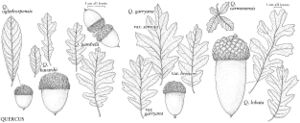Quercus lobata
Anales Ci. Nat. 3: 277. 1801.
Trees, deciduous, to 25 (-35) m, usually with solitary trunks. Bark gray, scaly, deeply checkered in age. Twigs yellowish, gray, occasionally reddish, 2-4 mm diam., densely or sparsely tomentulose. Buds yellowish or light-brown, ovoid, (2-) 3-5 (-6) mm, apex occasionally acute, densely pubescent. Leaves: petiole 5-12 mm. Leaf-blade broadly obovate or elliptic, moderately to deeply lobed, (40-) 50-100 (-120) × 30-60 (-75) mm, base rounded-attenuate, cuneate, or truncate, rarely subcordate, margins with sinuses usually reaching more than 1/2 distance to midrib, lobes oblong or spatulate, obtuse, rounded, or blunt, secondary-veins 5-10 on each side, apex broadly rounded; surfaces abaxially whitish or light green, densely to sparsely covered with interlocking appressed or semierect, 8-10 (-14) -rayed stellate hairs, adaxially dark green or grayish, glossy or somewhat scurfy because of sparse stellate hairs. Acorns solitary or paired, subsessile; cup deeply cupshaped, hemispheric or turbinate, rim thick, 10-30 mm deep × 14-30 mm wide, scales grayish or cream, more acute near rim, strongly and irregularly tuberculate, especially toward base of cup; nut light-brown, oblong or fusiform, 30-60 × (12-) 15-25 mm, tapering to acute or rounded apex. Cotyledons distinct.
Phenology: Flowering late winter–early spring.
Habitat: Valley floors and moderate slopes, open grasslands, savannah and oak woodlands, riparian areas in chaparral
Elevation: 0-1700 m
Discussion
Mature trees of Quercus lobata are among the largest oaks of the United States. The species hybridizes with numerous other species, but the hybrids are not common in most parts of its range. On Santa Cruz and Santa Catalina islands, however, occur extensive and relatively stable populations that show intermediate characteristics with Q. pacifica (see treatment). The hybrids have been given the name Q. ×macdonaldii, and they differ from Q. lobata in the following: leaf sinuses reaching less than half the distance to the midrib; leaves usually smaller, the lobes often more acute and brighter green; and acorns smaller, with more acute apices.
The Yuri used Quercus lobata in the treatment of diarrhea (D. E. Moerman 1986).
Selected References
None.

